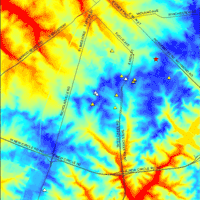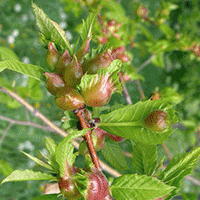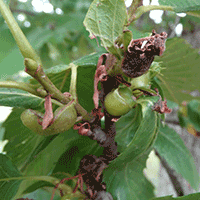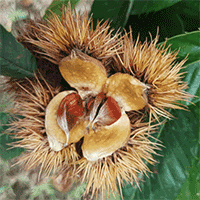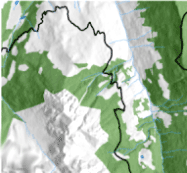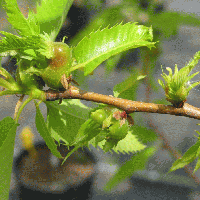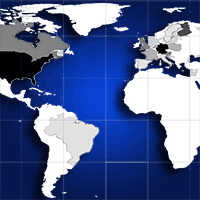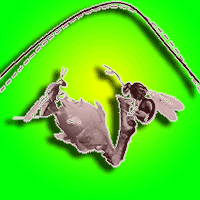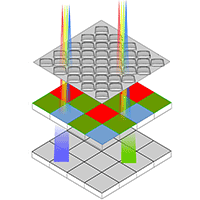Remote sensing and spatial analysis represent useful tools for modeling species’ dispersal, characterizing the spread of invasions and the invasability of a region, and thus allowing more accurate predictions for developing mitigation strategies. American chestnut, Castanea dentata, was historically a dominant forest species in North America, but occurs only sporadically today after its functional elimination by an exotic fungal pathogen in the early 1900’s. In recent decades Castanea resources have increased due to restoration efforts, commercial chestnut plantations, and horticultural uses. This resurgence is threatened by an additional exotic species, the globally invasive Asian chestnut gall wasp, Dryocosmus kuriphilus. The gall wasp was first discovered in Lexington, Kentucky (USA) in 2010. We used remotely sensed data and Geographic Information Systems to describe the local distribution of the Castanea hosts, and the occurrence and dispersal of the gall wasp. We tested the hypotheses that geomorphology, Castanea occurrence, and prevailing winds influence local proliferation. We found that gall wasp spread may be attributable to host plant distribution and to the effects of prevailing winds occurring during a brief period of adult insect emergence, and is influenced by topography. Our results suggest that weather data and topographic features can be used to delineate currently infested areas and predict future gall wasp infestations.
Keywords
, , , ,
Citation
Graziosi I, Rieske LK (2012). Local spread of an exotic invader: using remote sensing and spatial analysis to document proliferation of the invasive Asian chestnut gall wasp. iForest 5: 255-261. - doi: 10.3832/ifor0633-005
Academic Editor
Andrea Piotti
Paper history
Received: Apr 25, 2012
Accepted: Oct 06, 2012
First online: Oct 24, 2012
Publication Date: Oct 30, 2012
Publication Time: 0.60 months
© SISEF - The Italian Society of Silviculture and Forest Ecology 2012
Open Access
This article is distributed under the terms of the Creative Commons Attribution-Non Commercial 4.0 International (https://creativecommons.org/licenses/by-nc/4.0/), which permits unrestricted use, distribution, and reproduction in any medium, provided you give appropriate credit to the original author(s) and the source, provide a link to the Creative Commons license, and indicate if changes were made.

Breakdown by View Type
(Waiting for server response...)
Article Usage
Total Article Views: 64395
(from publication date up to now)
Breakdown by View Type
HTML Page Views: 53819
Abstract Page Views: 3258
PDF Downloads: 5592
Citation/Reference Downloads: 26
XML Downloads: 1700
Web Metrics
Days since publication: 4805
Overall contacts: 64395
Avg. contacts per week: 93.81
Article Citations
Article citations are based on data periodically collected from the Clarivate Web of Science web site
(last update: Mar 2025)
Total number of cites (since 2012): 11
Average cites per year: 0.79
Publication Metrics
by Dimensions ©
Articles citing this article
List of the papers citing this article based on CrossRef Cited-by.
(1)
Anagnostakis SL (2001)The effect of multiple importations of pests and pathogens on a native tree. Biological Invasions 3:245-254.
CrossRef |
Gscholar
(2)
Bolstad P (2005)GIS fundamentals: a first text on geographic information systems. Eider Press, Saint Paul, MN, USA.
Gscholar
(3)
Braun EL (1950)Deciduous forests of eastern North America. McGraw-Hill, NY, USA.
Gscholar
(4)
Carriere Y, Ellsworth PC, Dutilleul P, Ellers-Kirk C, Barkley V, Antilla L (2006)A GIS-based approach for area wide pest management: The scales of Lygus hesperus movements to cotton from alfalfa, weeds, and cotton. Entomologia Experimantalis et Applicata 118: 203-210.
CrossRef |
Gscholar
(5)
Clark JT, Fei S, Liang L, Rieske LK (2012)Mapping eastern hemlock: Comparing classification techniques to evaluate susceptibility of a fragmented and valued resource to an exotic invader, the hemlock wooly adelgid. Forest Ecology and Management 266: 216-222.
CrossRef |
Gscholar
(6)
Commonwealth of Kentucky (2011)Kentucky Geographic Division of Geographic Information Network. Commonwealth of Kentucky, KY, USA.
Online |
Gscholar
(7)
Dark SJ (2004)The biogeography of invasive alien plants in California: an application of GIS and spatial regression analysis. Diversity and Distribution 10:1-9.
CrossRef |
Gscholar
(8)
Eagles D, Deveson T, Walker PJ, Zalucki MP, Durr P (2011)Evaluation of long-distance dispersal of Culicoides midges into northern Australia using a migration model. Medical and Veterinary Entomology 26 (3): 334-340.
CrossRef |
Gscholar
(9)
EFSA (2010)Risk assessment of the oriental chestnut gall wasp,
Dryocosmus kuriphilus for the EU territory and identification and evaluation of risk management options (EFSA Panel on Plant Health PLH ed). European Food Safety Authority, Parma, Italy. EFSA Journal 8 (6): 1619.
CrossRef |
Gscholar
(10)
Epila JSO (1988)Wind, crop pests and agroforest design. Agricultural Systems 26: 99-110.
CrossRef |
Gscholar
(11)
EPPO (2005)Dryocosmus kuriphilus. European and Mediterranean Plant Protection Organization. EPPO Bulletin 35: 422-424.
CrossRef |
Gscholar
(12)
Graziosi I, Santi F (2008)Chestnut gall wasp (
Dryocosmus kuriphilus): spreading in Italy and new records in Bologna province. Bulletin of Insectology 61: 343-348.
Online |
Gscholar
(13)
Gressit JL, Yoshimoto CM (1974)Insect dispersal studies in northern Alaska. Pacific Insects 16:11-30.
Online |
Gscholar
(14)
Griffin GJ (2000)Blight control and restoration of the American chestnut. Journal of Forestry 98: 22-27.
Online |
Gscholar
(15)
Gyoutoku Y, Uemura M (1985)Ecology and biological control of the chestnut gall wasp,
Dryocosmus kuriphilus Yasumatsu (Hymenoptera Cynipidae). 1. Damage and parasitisation in Kumamoto Prefecture. Proceedings of the Association for Plant Protection of Kyushu 31: 213-215.
CrossRef |
Gscholar
(16)
Holcombe T, Stohlgren TJ, Jarnevich C (2007)Invasive pest management and research using GIS. In: Proceedings of the “International Symposium on Managing Vertebrate Invasive Species”. USDA/APHIS 2007, pp. 108-114.
Gscholar
(17)
Hough JS (1951)The effect of wind on the distribution of cynipid galls caused by
Neuroterus lenticularis Olivier. Journal of Animal Ecology 20: 165-168.
CrossRef |
Gscholar
(18)
Jenks GF (1967)The data model concept in statistical mapping. International Yearbook of Cartography 7: 186-190.
Gscholar
(19)
Johnson CG (1966)A functional system of adaptive dispersal by flight. Annual Review of Entomology 11: 233-260.
CrossRef |
Gscholar
(20)
Lemke D, Hulme PE, Brown JA, Tadesse W (2011)Distribution modeling of Japanese honeysuckle (
Lonicera japonica) invasion in the Cumberland plateau and Mountain Region, USA. Forest Ecology and Management 262: 139-149.
CrossRef |
Gscholar
(21)
Liebhold AM, Halverson JA, Elmes GA (1992)Gypsy moth invasion in North America: a quantitative analysis. Journal of Biogeography 19:513-520.
CrossRef |
Gscholar
(22)
Moser D, Drapela T, Zaller JG, Frank T (2009)Interacting effects of wind direction and resource distribution on insect pest densities. Basic and Applied Ecology 10:208-215.
CrossRef |
Gscholar
(23)
Oho N, Shimura I (1970)Research process on the chestnut gall wasp and some recent problems about its damage. Shokubutsu Boeki (Plant Protection) 24: 421-427.
Gscholar
(24)
Pasek JE (1988)Influence of winds and windbreak on local dispersal of insects. Agriculture Ecosystems and Environment 22: 539-554.
CrossRef |
Gscholar
(25)
Payne JA, Jaynes RA, Kays SJ (1983)Chinese Chestnut production in the United States: practice, problems, and possible solutions. Economic Botany 37:187-200.
CrossRef |
Gscholar
(26)
Reynolds DR, Riley JR (2002)Remote-sensing, telemetric and computer-based technologies for investigating insect movement: a survey of existing and potential techniques. Computers and Electronics in Agriculture 35: 271-307.
CrossRef |
Gscholar
(27)
Rieske LK (2007)Success of an exotic gallmaker,
Dryocosmus kuriphilus, on chestnut in the USA: an historical account. EPPO Bulletin 37: 172-174.
CrossRef |
Gscholar
(28)
Riley JR (1989)Remote sensing in Entomology. Annual Review of Entomology 34: 247-71.
CrossRef |
Gscholar
(29)
Rouget M, Richardson DM, Milton SJ, Polakow D (2004)Predicting invasion dynamics of four alien Pinus species in a highly fragmented semi-arid shrubland in South Africa. Plant Ecology 152: 79-92.
CrossRef |
Gscholar
(30)
Schnase JL, Smith JA, Stohlgren TJ, Graves S, Trees C (2002)Biological invasions: a challenge in ecological forecasting. In: Proceedings of the “Geosense and Remote Sensing Symposium”, vol. 1, pp. 122-124.
Gscholar
(31)
Underwood E, Ustin S, Di Pietro D (2003)Mapping nonnative plants using hyperspectral imagery. Remote Sensing of Environment 86: 150-161.
CrossRef |
Gscholar
(32)
USGS (2011)National Elevation Dataset. US Geological Survey, USA.
Online |
Gscholar
(33)
Warton ME, Barbour RW (1973)Trees and shrubs of Kentucky. University Press of Kentucky, Lexington, KY, USA.
Gscholar
(34)
Western Kentucky University (2011)Kentucky Climate Center. Web Site.
Online |
Gscholar
(35)
Wulder MA, Dymond CC, White JC, Leckie DG, Carrol AL (2006)Surveying mountain beetle damage of forests: A review of remote sensing opportunities. Forest Ecology and management 221: 27-41.
CrossRef |
Gscholar
